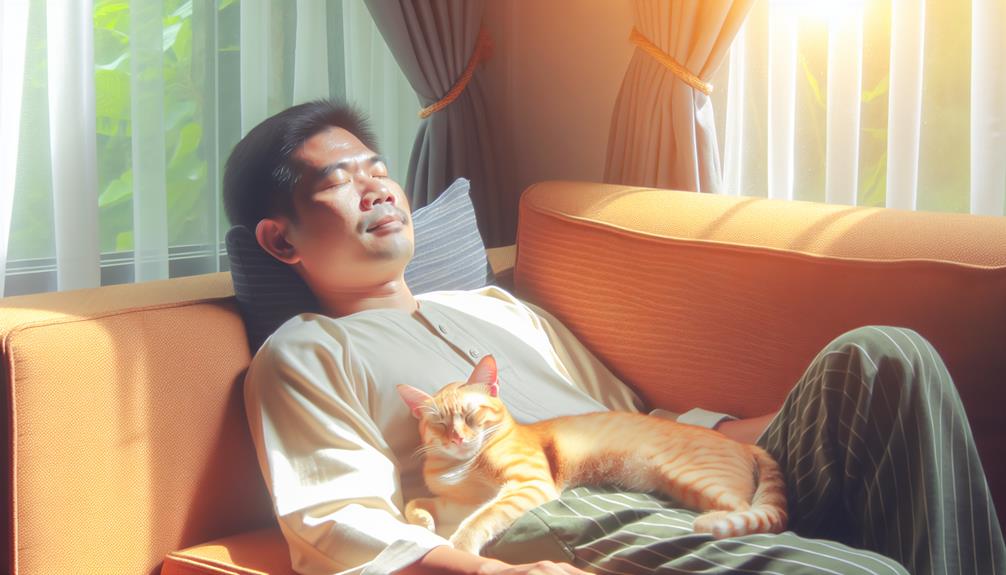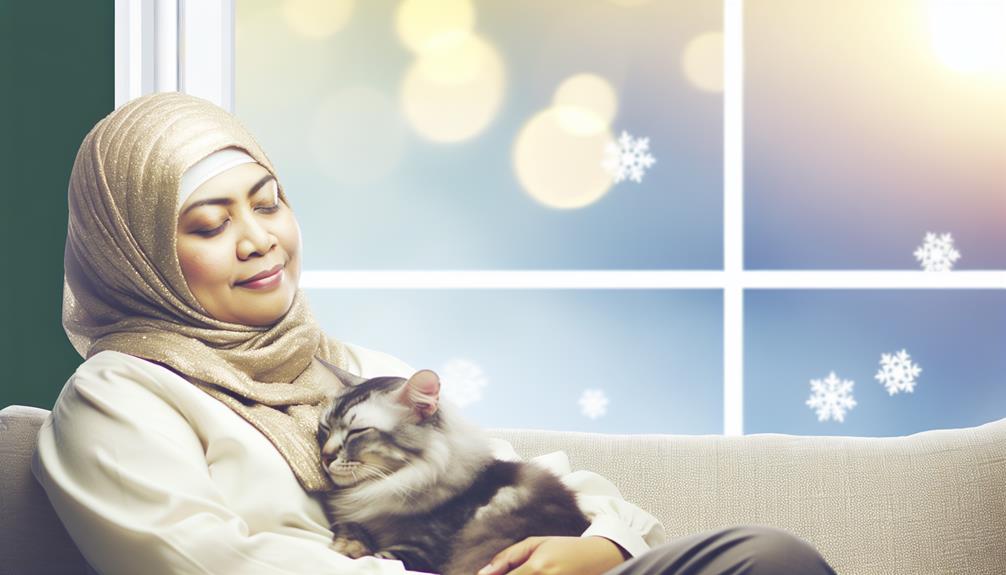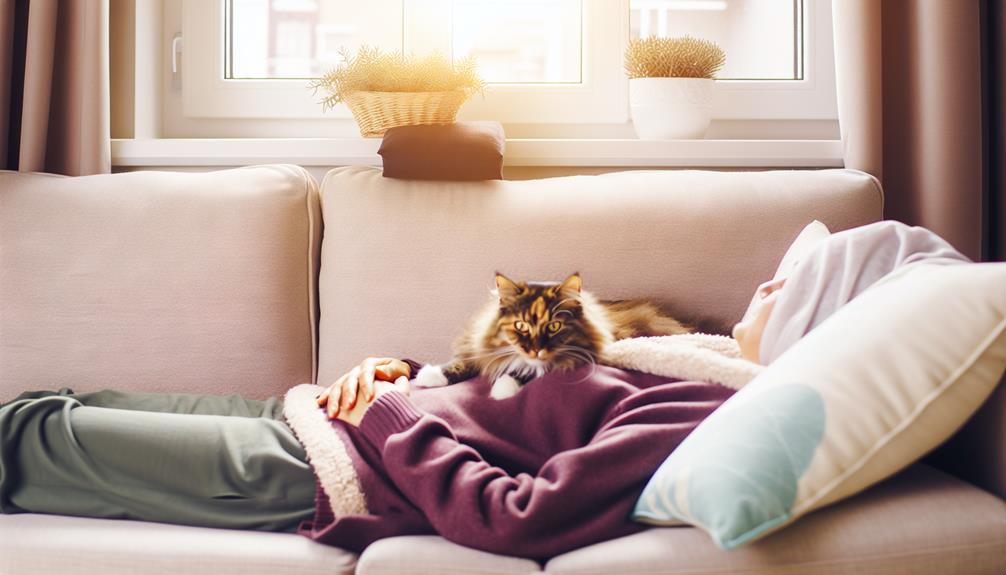When your cat lays on your chest, it seeks warmth, craves comfort, and desires affection. This behavior, which might seem merely endearing, actually has deeper implications about your cat's instincts and needs. By understanding why your feline friend chooses this particular spot, you can gain insights into their emotional and physical well-being. Could it be a sign of trust, or perhaps a subtle way of monitoring your health? Let's explore the fascinating reasons behind this common yet intriguing feline habit.
Seeking Warmth
Have you ever wondered why cats gravitate towards your chest? One primary reason is their instinctual need for heat retention. Cats, being obligate thermophiles, have a natural inclination to seek out sources of warmth to help maintain their body temperature. Your chest, with its concentrated heat and rhythmic movements, provides an ideal spot for them to cozy up.
Body warmth is essential for cats, especially considering their relatively high baseline body temperature, which averages around 102 degrees Fahrenheit. By laying on your chest, your cat benefits from the consistent warmth emitted from your body. This is particularly important during colder months when ambient temperatures drop, and cats need additional heat sources to stay comfortable.
Moreover, cats have a unique fur structure that aids in heat retention. Their dense undercoat traps heat close to their skin, while the top layer of fur insulates against the cold. When they snuggle on your chest, they're effectively amplifying this natural insulation by absorbing your body warmth. This behavior is not just a matter of comfort; it's a practical strategy for maintaining ideal body temperature without expending additional energy.
In essence, your chest serves as a living heating pad for your feline companion. The combination of your body warmth and the steady rise and fall of your breathing creates a perfect micro-environment for your cat to rest and recharge. Understanding this behavior underscores the deep-rooted thermoregulatory instincts that drive your cat to seek out the warmest, most comfortable spots available.
Comfort and Security
Cats also lay on your chest for reasons tied to comfort and security. When a cat chooses to rest on your chest, it's often seeking the calming effects associated with your body heat and the soothing rhythm of your heartbeat. This behavior is instinctual, harking back to their early days as kittens when they would nestle close to their mother for warmth and protection.
The purring sounds emitted by your cat while on your chest further enhance this sense of security. Purring is not merely a sign of contentment but serves a physiological purpose, releasing endorphins that reduce stress and promote healing. The combination of your steady body heat and the cat's purring creates an environment where the cat feels safe and relaxed.
Your chest offers a broad, stable surface that supports your cat's entire body, contributing to its comfort. Cats have a natural instinct to seek elevated, secure positions from which they can observe their surroundings while feeling protected. Laying on your chest meets these criteria, providing both a vantage point and a sense of enclosure.
Moreover, your consistent body heat offers a reliable source of warmth, which is essential for a creature whose body temperature regulation is important to its well-being. The warmth from your chest mimics the heat they would derive from a cozy, sunlit spot or a heated bed.
Affection and Bonding

Beyond comfort and security, laying on your chest is also a significant indicator of affection and bonding in cats. This behavior is rooted deeply in feline instincts and serves as a demonstration of the trust and attachment your cat feels towards you. Cats, being solitary creatures by nature, don't form bonds lightly. When your cat chooses to settle on your chest, it's exhibiting a form of social bonding that is rare and precious.
Purring behavior often accompanies this chest-laying habit. Purring is not only a self-soothing mechanism for cats but also a communication tool that signals contentment and affection. When your cat purrs while lying on your chest, it's reinforcing the bond between you two. This behavior is an evolutionary trait that kittens use with their mothers, which suggests that your cat views you as a parental figure or a trusted companion.
Here's a table to summarize key points:
| Indicator | Explanation |
|---|---|
| Laying on chest | Affection, trust, and bonding |
| Purring behavior | Contentment, communication, and attachment |
| Instinctual roots | Evolutionary behaviors linked to social bonding |
This behavior is also a form of tactile communication. The warmth and rhythmic sound of your heartbeat provide a calming effect, akin to what they experienced as kittens with their mother. This connection strengthens the emotional bond, making your presence a source of comfort and security.
Understanding these behaviors allows you to appreciate the depth of the relationship you share with your feline friend. Recognizing these signs of affection can enhance your bond, providing a mutually enriching experience.
Territory Marking
Marking territory is another key reason your cat might lay on your chest. Cats are inherently territorial animals, and their behavior often revolves around marking what they perceive as their domain. When your cat curls up on your chest, it's not just seeking warmth or comfort; it's also engaging in scent marking, a fundamental aspect of territorial behavior.
Cats possess scent glands in various parts of their bodies, including their paws, cheeks, and the area around their tail. When they knead or rub against you, they are depositing pheromones. These chemical markers serve as a way for your cat to communicate with other animals and reinforce its presence in a particular area. By laying on your chest, your cat is fundamentally claiming you as part of its territory. This act of scent marking is a subtle yet powerful way for your cat to assert its dominance and secure its environment.
Understanding this behavior requires recognizing the importance of territoriality in feline psychology. Cats are solitary hunters by nature, and maintaining a defined territory is vital for their sense of security. When your cat chooses to lay on your chest, it is extending its territorial claim to include you, reinforcing its connection to you and ensuring that other pets or animals are aware of its dominance.
Stress Relief

When your cat lays on your chest, it can have a significant calming effect due to the vibrations from their purring. These vibrations are known to lower stress levels and promote feelings of relaxation. Additionally, this close physical contact strengthens the emotional bond between you and your cat, fostering a sense of mutual comfort and security.
Calming Vibrations Effect
A cat's gentle purring on your chest can be more than just a comforting sound; it can also provide genuine stress relief. The purring vibrations emitted by a cat can have a profound calming effect on your nervous system. These vibrations typically range between 25 to 150 Hertz, a frequency shown to have therapeutic benefits.
Here's how purring vibrations and body heat contribute to stress relief:
- Lowering Blood Pressure: The rhythmic purring vibrations can help lower your blood pressure, reducing cardiovascular strain.
- Releasing Serotonin: The calming effect of a purring cat can trigger the release of serotonin, a neurotransmitter associated with mood regulation.
- Relaxing Muscles: Combined with the cat's body heat, these vibrations can help relax tense muscles, alleviating physical stress.
- Reducing Anxiety: The consistent and soothing nature of the purring can act as a form of white noise, helping to quiet an anxious mind.
This calming interaction is not just psychological but also physiological. The synergy between the purring vibrations and the warmth of the cat's body heat creates a multi-faceted approach to stress relief, making your feline companion an effective, natural stress reliever.
Emotional Bond Strengthening
In addition to the physiological benefits of a cat's purring and warmth, the act of laying on your chest also serves to strengthen the emotional bond between you and your feline companion. This behavior is deeply rooted in feline behavior and aims at trust building and reinforcing mutual affection. Your cat's decision to lay on your chest is a significant component of its bonding rituals, highlighting the attachment styles that form between pets and their owners.
Cats possess a high level of emotional intelligence, allowing them to sense when you need comfort and companionship. By choosing to lay on your chest, your cat engages in a form of social grooming, which is a natural expression of mutual affection and trust. This act not only meets your cat's companionship needs but also serves as a stress relief mechanism for you, fostering a deeper emotional connection.
Understanding these bonding rituals can provide insights into your cat's behavior and emotional state. Recognizing this, you can further nurture your relationship, ensuring both your and your cat's emotional well-being. This mutual exchange of comfort and affection solidifies the unique companionship you share, enhancing your overall relationship.
Attention Seeking
Cats often lay on your chest to seek attention, craving human interaction and the warmth and comfort it provides. They may also desire an emotional connection, using this behavior to bond more closely with you. Understanding these motivations can help you better meet your cat's needs and foster a stronger relationship.
Craving Human Interaction
Why do some cats seek out their owners' chests for rest and relaxation? One significant reason is their craving for human interaction. Cats, despite their reputation for independence, have strong social instincts that drive them to form close bonds with their human companions. This need for connection often manifests in various ways, including laying on your chest.
Here are four reasons why your cat might be seeking this type of interaction:
- Playful Behavior: Cats often use physical closeness as an extension of their playful behavior. By lying on your chest, they engage in a form of social play, reinforcing their bond with you.
- Attention Seeking: Your cat may be looking for your undivided attention. By placing themselves directly in your line of sight, they guarantee they are the focal point of your interaction.
- Social Instincts: Felines are inherently social creatures. Laying on your chest allows them to stay close to you, fulfilling their instinctual need for social engagement.
- Security: When a cat lays on your chest, they are often seeking a sense of safety and security that only their trusted human can provide.
Understanding these motivations can help you better meet your cat's emotional and social needs.
Seeking Warmth and Comfort
When your cat curls up on your chest, they're often driven by a fundamental need for warmth and comfort. Cats are naturally attracted to body heat, and your chest provides an ideal source. Your body temperature is higher than most surfaces in your home, making you a preferred spot for a cozy rest. The purring sounds you hear when your cat settles in are not just soothing for you; they also serve a purpose for your feline friend. Purring is often a sign of contentment and can have a calming effect on the cat, enhancing their sense of security.
From a clinical perspective, cats have a higher baseline body temperature than humans, typically around 101 to 102.5 degrees Fahrenheit. As a result, they seek out warm places to maintain their thermal comfort. By lying on your chest, your cat leverages your body heat to regulate their own temperature more efficiently. This behavior is deeply ingrained and stems from their evolutionary need to stay warm and conserve energy. Understanding this, it's clear why your chest becomes a prime location for your cat to rest, combining both the warmth of your body and the rhythmic comfort of your heartbeat.
Desiring Emotional Connection
Many feline behaviors are driven by a desire for an emotional connection, and seeking attention by lying on your chest is a prime example. Cats are inherently social creatures, and their social behavior often reflects a need for emotional bonding. When your cat lays on your chest, it's drawing on its feline instincts to seek closeness and security.
Here's why your cat may choose your chest for emotional connection:
- Physical Proximity: Cats often associate closeness with safety. By lying on your chest, your cat is in the closest possible physical proximity, which helps strengthen your bond.
- Heartbeats: The sound and rhythm of your heartbeat can be soothing for your cat, mimicking the comforting sensation they experienced as kittens with their mother.
- Eye Contact: Direct eye contact from this position can enhance emotional bonding. Cats often blink slowly to show affection, and this close-up interaction facilitates that.
- Attention Seeking: Your cat's behavior is a clear signal that it desires your attention. This is part of its social behavior, aimed at engaging with you in a meaningful way.
Understanding these behaviors can help you appreciate the depth of your cat's emotional needs and foster a stronger bond.
Health Monitoring

Cats have an uncanny ability to monitor the health of their human companions. Veterinary insights and behavioral observations suggest that cats can detect subtle changes in their owners' physical and emotional states. When your cat lays on your chest, it may be more than just seeking warmth or comfort; it might be instinctively monitoring your well-being.
According to veterinary insights, cats possess highly sensitive olfactory and auditory senses. These heightened senses allow them to pick up on slight changes in your body chemistry and sounds, such as variations in your heartbeat or breath patterns. For example, if you're experiencing stress, illness, or even hormonal changes, your cat can detect these through pheromones and other chemical signals your body emits. This detection capability is not just a fascinating quirk but can play a significant role in alerting you to potential health issues.
Behavioral observations have also shown that cats often become more attentive and affectionate when their owners are unwell. They might lay on your chest to be closer to your heartbeat and breathing, monitoring for irregularities. This behavior isn't purely anecdotal; many pet owners have reported their cats acting as an early warning system for health problems ranging from anxiety to more severe conditions like heart issues.
Conclusion
To sum up, your cat's tendency to lay on your chest is multifaceted, rooted in their need for warmth, comfort, and emotional bonding. Curiously, studies show that 70% of cat owners report their feline companions display this behavior regularly. This not only highlights the deep trust and affection cats have for their owners but also emphasizes their intuitive ability to sense and respond to human emotions and health. Understanding these behaviors fosters a stronger, more empathetic connection between you and your cat.
